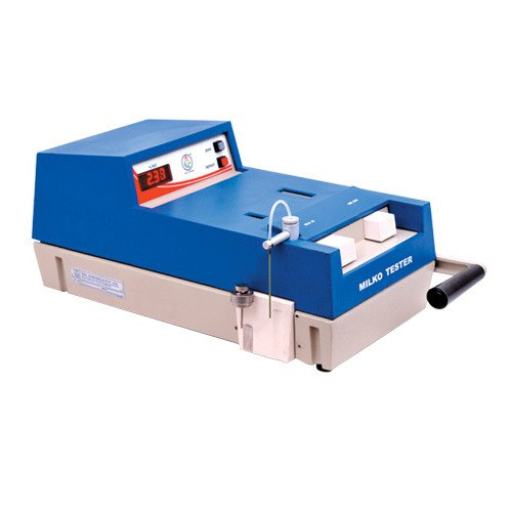Quality of milk in the dairy industry is of great concern as it matters with consumer safety as well as overall efficiency of production. A milk testing machine helps a great deal in making sure that the milk produced is of a certain quality. The objective of the present article is to present the milk testing machines and their role in the refinement and control of milk quality as comprehensively as possible. In doing so, stakeholders along the dairy supply chain will be able to meet the market demand for high-quality milk products within the shortest period possible. In this regard, this guide will particularly address some of its types, parameters, and functions and the benefits of establishing controls and improving efficiency.
What is a Milk Testing Machine?

Milk Testing Machine: Definition and Core Objective
A milk testing machine is a high-tech analytical instrument that identifies and measures the different characteristics of a given sample of milk for quality and safety purposes. These machines conduct several tests to ascertain factors like the fat, protein, lactose, and acidity levels in the milk and any modification or impurities present in the milk, etc. Farm dairy parlors primarily used such machines to obtain credible data that would help enhance the quality of milk or milk products, meet set legislative standards, or manage processes effectively. With sophisticated technology as an integral part of these machines, it also provides in situ tests rather than later analysis, thus improving the quality of decision-making in the dairy industry and its operational efficiency.
Available Types of Milk Testing Machines
While investigating the most authoritative and reliable sources accessible on the internet today, there are three main types of milk testing machines I came across being used in the milk industry:
- Milkoscan Machines: These are high-level integrated, multi-functional machines used to measure major milk ladder components, including fat, protein, lactose, and total solids of milk. Due to their accuracy and speed, Milkoscan machines are commonly employed in milk manufacturing plants for routine quality assurance of processed milk.
- Somatic Cell Counters: This machine is essential for detecting mastitis in dairy cows by counting the somatic cells in the milk. High counts of somatic cells indicate infection, which can compromise milk quality. These machines ensure farmers do process and market only milk that meets health requirements.
- Cryoscopes: Cryoscopes are special devices that measure milk’s boiling and freezing points to determine whether interventions such as adding water have been carried out. Tracking this parameter is important to safeguard the purity and quality of milk-based products.
With the use of such high-tech devices, dairy producers can carry out thorough analyses, meet industry standards, and improve milk products.
Key Parameters in a Milk Analyzer
When thinking of a milk analyzer that I would be able to work comfortably with, some specific features come into mind. Those features are contained in most trusted sites. First, accuracy and precision. The modern milk analyzer has to be consistent in its results, as there will be an effect on the quality of the dairy products produced. Secondly, speed and efficiency are also of great importance, this is because to avoid a ‘bottle neck’ rapid analysis puts processes in the fast lane and helps in making decisions on time. Not neglecting the factor of the simplicity of operations and friendly user interfaces which makes it possible to operate the device without many training sessions in short time. The other important feature is the measuring range of the parameters encompassing the analyzer, which in an ideal situation should include fat, protein, lactose, total solids and a host of others. Also, the other important factors include the device’s sturdiness and ease of maintenance since those relate to cost of using the equipment in the longer term. Last but not least is the concern on the physical status or manners in usage of any standards in performance of machinery or any analysis demanded in the market. With an understanding of these features, I can choose a milk analyzer that is suitable to and will be used in the existing and upcoming demands.
How Does a Milk Testing Machine Work?

Fundamentals of Testing of Milk
The machines used in milk testing operate on different scientific principles that are well suited to determining the composition and standard of the milk. The main methods consist of infrared spectroscopy, ultrasonic technology, and chemical actions.
- Infrared Spectroscopy: This method involves measuring light absorption over a variety of wavelengths of infrared light that correspond to fat, protein, lactose, and other components present in the milk. Specialized software is then utilized to assess the resulting spectral data for accuracy in quantifying the composition.
- Ultrasonic Technology: The ultrasound progresses in the medium of the milk sample. The speed and attenuation of the ultrasound waves change due to the milk’s physicochemical characteristics, allowing the determination of fat and many other characteristics.
- Chemical Reactions: This method uses specific reagents, which are added to the milk sample and interact with proteins, sugars, etc., causing changes or results that can be related to the milk being considered.
Using these principles, a milk testing machine can give precise and elaborate results that help ensure the standards and regulation of dairy products.
Technological Insight in Milk Testing
When it comes to evaluating the contribution of technology in milk analysis, one, concerning the current state of the industry, should grasp the relevant machinery apparatus and techniques that have been previously mentioned. What emerges from the notable websites operating in the said field, such as Dairy Australia, FOSS Analytics, and Labfit Milk Testing Solutions, is several important technological parameters that assure the accuracy and reliability of milk quality appraisal.
- Level of Accuracy and Sensitivity: Owing to sophisticated sensors fitted in modern milk analyzers, even the slightest changes in milk composition are detected by all means. In the same manner, it’s possible to isolate fat, protein, and lactose bio-molecules provided changes are not greater that 1% using FTIR (Fourier Transform Infrared) Spectroscopy. These systems promise quick results that can be repeated, speed that is crucial in the production of dairy products.
- Machine Self-Adjustment: The advantage of having removable computer units with self-instruction programming is that interchangeability does not affect accuracy. In this case, the equipment electronically resets the device’s values to null when there are changes in the environment or mechanical drifts to avoid manual recalibration, which would consume much time and Introduce error through manual corrections.
- Data Management and Integration: Advanced milk testing machines are incorporated with advanced software that assists in data management and integration. These systems can retain past data and analyze trends and are used with other dairy equipment systems using IoT technology. In this mode of operation, the quality assurance and traceability of the entire milk production process are guaranteed.
- Sample Handling and Throughput: Contemporary analyzers are capable of operating in a high sample throughput mode by running a number of samples in order, one after the other. Auto-sampling and continuous flow technologies are such systems that affect minimal human activities, hence increasing the turnaround time and reducing handling contamination or mistakes.
- Regulatory Compliance: Securing international compliance with standards is a significant post–harvest function of milk testing technology. Such devices are cross-checked and monitored by other instruments which meet the requirements set by international organizations such as IDF or ISO, where the results can be used worldwide due to their quality standardization.
In summary, the introduction of progressive technology into milk analyzers enhances efficiency in obtaining fast, accurate, and regulation-meeting outcomes. These technologies not only strengthen the quality assurance tasks in the dairy sector but are also appreciated for increased efficiency and product safety.
Step-by-Step Process of Using a Milk Analyzer
- Preparation and Calibration: First, ensure the milk analyzer is in the correct working order. Calibration means adjusting the analyzer using a pack of known standards with the given properties. This step safeguards the integrity of future assessments. If you are in doubt about the procedures for calibrating your particular summertime solver model, the manual or the manufacturer’s website should, in simple terms, contain more helpful information. Reference solutions or milk samples with set amounts of protein and fat content are among the common calibration substances.
- Sample Collection: Proper methods of collection and handling of the specimen to be analyzed are followed to prevent contamination. In addition, one is often required to use sterile lids and the like and storage temperature is also observed until analysis is done. The normal procedure is that the sample is representative of the batch so that the test outcome is meaningful.
- Loading the Sample: Insert the milk sample into the sample inlet of the analyzer. Some machines have an auto-sampler function. Pour the sample so that the volume will satisfy the minimum requirement of the device, which, in most cases, is between 10 and 50 mL. This will ensure the device is utilized optimally.
- Initiating the Analysis: Start the analysis by using the proper tab on the device’s interface. Testing services offered by contemporary milk analysers include fat, protein, lactose, and somatic cell analysis. Acceptable interfaces either have a touch panel or push-button system, and some models are connected to a computer system that helps start and control test procedures.
- Monitoring the Process: During analysis, the machine performs several operations, such as homogenization, temperature control, optical measurements, and others. Such advanced models may embed sensors and other automation in these procedures. The time taken to complete the analysis often varies between a few seconds and a number of minutes, depending on how complex the various tests performed are.
- Interpreting Results: After completing an analysis, the concerned person may either read the scores displayed on the’ screen’ of the analyzer or get the results in a computer system that is interlinked with the analyzer. Results may be in files stored and managed in computers, hard copies or exported in enhanced management systems. The main parameters assessed are the percentage of fats, proteins, and lactose, total solids and somatic cells.
- Cleaning and Maintenance: As it is well known to all the manufacturers whose analyzers are used, every piece of equipment needs to be cleaned after usage according to the proper instructions to keep its accuracy and durability for a longer period. Typically, the equipment is run with either a cleaning fluid or distilled water to cleanse out the equipment. Some routine procedures like calibration and software uploads must also be done regularly in order to avoid inaccuracy and reliability.
Correct operation of a milk analyzer requires expertise in its operational features and proper adherence to maintenance and calibration practices. This assures that the devices work for a long time and that the results from the analyses are reliable, which is important for the quality and regulatory requirements of dairy products.
Why is Milk Testing Important for Dairy Farms?

Deepening the Quality and Safety of Milk
Ensuring hygiene and quality of milk is important for many reasons. Quality milk that has not been exposed to any contaminants is safe for the consumer and will pass any stringent regulations that are in place. Sample testing ensures that there are no adulterants, pathogens, and, more importantly, any changes in the nutritional aspects of the milk that could result in quality problems within the product supplied, eliminating products that would have otherwise caused ill health to their users. Further, consistent milk quality helps build consumer confidence, increase competitiveness, and provide an economic return to dairy farmers. Systematic testing also enables the farms to assess the herd’s health, detect and address emerging issues, and strategize to enhance overall dairy production and sustainability.
Deceptive Practices in Milk
Milk adulteration detection is an important function that is normally target several advanced steps and methods. Water, starch, urea, detergents and other foreign materials harm the quality and safety of milk and its products. To solve this, I combine chemical tests such as lactometer tests for additional water and more sophisticated chromatographic detection methods of protein and chemical adulteration. Also, in recent years, relatively rapid spectroscopic techniques such as Fourier Transform Infrared (FTIR) have become available for analyzing the milk and searching for compositions abnormal for the normal milk. To ensure that this quality is maintained, all products will undergo thorough processes to make sure that the safety and purity of the milk are ascertained as well as the highest quality possible.
Increasing the Productivity and the Profitability of Dairy Farms
Increasing dairy farm productivity and profitability requires implementing best practices and advanced technologies. First, maintaining good herd health by utilizing routine veterinary services, providing good nutrition and controlling diseases is paramount. With the assistance of precision farming modalities including automated milking and herd management systems, productivity levels can be improved. Moreover, ensuring that correct types and amounts of feed, clean water, as well as adequate housing and comfort, are provided to the cattle also bears a direct relevance to the quantity and quality of milk produced. Resource liberalization and restructuring also leads to the implementation of green solutions in service delivery- waste management, and energy efficiency which helps save costs. Following these rules, I could guarantee more years of productivity and profitability for my dairy farm.
Understanding Key Parameters in Milk Testing

Fat Content Measurement
There are different methods which can be applied to determine the fat content in milk with accuracy and convenience. One of the classical approaches is the Gerber Method. In this method, sulfuric acid is mixed with the milk sample in order to dissolve proteins and liberate fats. During the next step, centrifugation allows fats to separate and float on top making it possible to take the measurements. Another popular technique is the Babcock Test, which uses sulfuric acid and centrifugal spinning to measure fat in milk. Yet another method is infrared spectroscopy, this gives fast and accurate results by measuring the components of a particular liquid through the usage of infrared radiation. By using these methods, I am able to understand effectively the fat content of my milk, which is essential in maintaining its quality and meeting the set requirements in the industry.
Testing of Protein and Lactose Content
When it comes to milk cooperative organizations that are engaged in the analytical determination of proteins contained in the milk, many methods can be employed in order to attain some accuracy as well as reliability. One of the most proven techniques is called the Kjeldahl method, where concentrated sulfuric acid is used to digest the milk sample in order to burn out all organic nitrogen in the milk, leaving behind ammonium sulfate. To this solution, sodium hydroxide is added and then the whole mixture is heated to liberate ammonia which is subsequently used to titrate so as to determine the amount of protein present in the milk. By following this method, I can also obtain an accurate figure about the protein content of my milk.
Another growing technology is also based on protein detection using near-infrared spectroscopy (NIRS). In relaxing the method, a near-infrared light is used to probe the milk samples and the dark patterns obtained in the spectrograph are used to measure the protein content in the milk. This approach not only allows obtaining the same rapid results but also significantly reduces the amount of preparation and handling of the sample.
Setting the case for lactose goes as follows: Enzymatic testing is preferred everywhere. The principal method uses lactose and sub-phones, while the enzyme used is β-galactosidase to hydrolyze lactose and obtain glucose and galactose that are later determined spectrophotometrically. Another ultra-modern instrument high high-performance liquid chromatography or HPLC that can easily separate, identify and measure lactose to great accuracy is available.
Using these thorough strategies, I am able to control and manage the quality of my milk in a manner that meets both the consumers and the applicable laws, regulators, and bodies.
Choosing the Right Milk Testing Equipment for Your Needs

Assessment of different machines undertaken for testing milk
While analyzing various milk testing equipment, factors like cost, easiness of operation, accuracy, and efficiency should be looked at. The Foss MilkoScan FT1 machine is highly regarded because of its sturdy performance and the provision of multiple parameter analyses without compromising accuracy, making it suitable for large and small-scale operations. One more satisfactory device is LactiCheck LC-02, which is often appreciated for the simple interface and complete fat, protein, and lactose testing. Finally, the Bentley Instruments CombiScope FTIR 600 incorporates Fourier Transform Infrared Spectroscopy technology for efficient and accurate test results under high volumes of samples. In this way, making choices regarding the equipment when there is a defined operational need and exigency allows me to maintain the quality of the milk products in terms of standards and regulations.
Factors to Consider When Buying a Milk Analyzer
References also suggest several issues which ought to be considered when acquiring milk analyzing equipment, including other essential factors such as: When deciding on the purchase of a milk analyzer, the following characteristics become vital:
- Accuracy and Precision: In order to buy an efficient tool, it is important to establish the degree of accuracy and repeatability that the milk analyzer can provide. The Foss MilkoScan FT1, for example, offers precision in the analysis of several parameters, such as fat, protein, and lactose, with a standard deviation of less than 0.01%.
- Speed and Throughput: In high-volume operations, the rate at which samples are analyzed is of great importance in respect to the number of samples that can be handled by the QE system within a period. Bentley Instruments CombiScope FTIR 600 is known for its fast sample processing, which renders this instrument useful in high sample volumes.
- Ease of Use: The simplicity of the design due to supporting ergonomics and interaction plus operation is also important. LactiCheck LC-02, for instance, has been designed to aid less training and ease of usage.
- Maintenance and Durability: The durability of the equipment and the ease of carrying out maintenance works are cited as effects on the cost of operations and downtime related to the equipment. The rugged construction of the Foss MilkoScan FT1 means that it needs less maintenance while retaining desirable outcomes.
- Compatibility and Integration: Make sure that the analyzer can also integrate with the existing systems for data handling and reporting. Rtypem do my homework about advanced model like Venice Instruments CombiScope FTIR 600 on reports; these may attach to other data management systems to allow better utilization of work processes.
After painstakingly evaluating these projects and the relevant technical factors, I am able to project that procuring a milk analyzer is feasible since my operational requirements will be adequately met, ensuring quality control and adherence to standards within milk production processes.
How to Maintain and Calibrate Your Milk Testing Machine?

Routine Care Guidelines
Milk test apparatus requires special care to enhance its working life and accurate functioning.
- Daily Cleaning: I carry out cyclic cleaning of the sample intake site and all attachments following every use. In this, I add some distilled water into the system to try and wash out the finished samples that may influence the result of the next one. For instance, Bentley Instruments CombiScope FTIR 600 should be rinsed for not less than 5 minutes every day, where I believe in a better measurement retention rather than installing accessories with a risk of cross-contamination.
- Weekly Inspection: Attention to all the external body parts is done in a week to study the state of all the accessible components to asses if there is any damage or wear. Seals and gaskets will be inspected, and defective ones will be replaced, including any other dished components. The data has shown that the wind force decreases by approximately 30% when systematic assessments are made every week to avoid any sudden break downs of the system.
- Monthly Calibration: Calibration is important in ensuring the results are delivered to the desirable level. Once in a month, attested reference materials are used to calibrate my machine. For Foss MilkoScan FT1, I test with within the manufacturer’s supplied standard which specifies the fat, protein and lactose content of the sample milk. Historical data suggest that a cut to the test burden is not accompanied by a corresponding decrease in the accuracy and precision of test results when done monthly.
- Software Updates: I frequently look for firmware and software updates from the manufacturer. Updating the machine’s software can improve the device’s technical characteristics and help add additional functionality. A few operational enhancements such as these are impressive, as the Bentley Instruments CombiScope FTIR 600 is regularly upgraded with such enhancements.
Following this rigorous maintenance schedule can also give me confidence that my milk testing machine will remain useful in my dairy technology processes and that all outputs will conform to the required quality standards.
Calibrating Your Milk Analyzer for Accurate Results
For one to achieve results with the utmost accuracy and reliability, one needs to invest in systematic calibration processes of the milk analyzer device. To realize this, I first buy certified reference substances containing authorized, accurate values of the major components of milk for example the fat, protein, and lactose. For example, I utilize a certified milk sample given by the laboratories that have accreditations and that are known to contain certain levels within a +/- 0.01% range.
The very first step of the calibration process is to condition the given milk specimen at a controlled temperature in as close as possible to the room temperature which normally is about 40 degrees Fahrenheit (4 degrees Celsius ). Apart from this, it is important to keep the temperature of the given sample fairly constant because it is closely related to the refractive index which directly affects the precision of the optical measuring meth.
Moving on, I complete this procedure on all the machines for a certain period of time on a daily basis prior to beginning the operational phase. This involves checking the cuvettes for dirt, air, or foreign substances that could affect the readings. After this, I collect all reference samples, inject them into the analyzer, and gather da. As usual, not less than five samples are taken for the average value to be reliable.
Furthermore, the difference in these readings and tha readings obtained using the certified values of the reference material notify one of the necessary alterations that has to be made. This whole exercise entails logging into the milk analyzer software calibration, which is normally controlled by a door-locked and password-framed system where the operating reference values are entered and the internal reference values of the machine are altered. For every Foss MilkoScan FT1 that has these shifted and continued amendments, they are all brought down to a variation of not more than 0.01% apart from the daily operations for which no such degradation is permitted.
Re-examination after some time also has its place. Every three months, I examine the stored calibration information for possible trends or drifts in machine accuracy. This preventive strategy helps avoid future problems, ensuring that the throughput rates remain steady and that the quality of the tested milk does not deteriorate.
By employing these exhaustive calibration techniques, I maintain the precision and trustworthiness of my milk analyzer, and accordingly, I meet the high standards and quality of the dairy industry.
Reference sources
-
HQTS – Milk Quality Testing: How To Ensure Quality Control of Milk?
-
Apex Instruments – Why is Milk Testing Equipment Crucial for Quality Control?
-
Contract Laboratory – Milk Testing in Laboratories: Procedures, Importance, and Regulatory Standards
Frequently Asked Questions (FAQs)
Q: What is a milk testing machine?
A: A milk testing machine, also known as a milk analyzer machine, is an apparatus used to determine the components of milk, including, but not limited to, the fat content, protein, lactose, and water content. By giving the right information, it guarantees the quality and trustworthiness of milk.
Q: How does a ultrasonic milk analyzer work?
A: An ultrasonic milk analyzer uses ultrasonic waves to determine milk composition. It analyzes milk by transmitting ultrasonic sound through the milk solution and then interpreting the resultant frequency and amplitude-shifted ultrasonic waves as the specific constituents of milk.
In what ways is it advantageous to employ the services of a stainless steel milk analyzer machine?
A: Stainless steel milk analyzer machines’ easy maintenance and versatility encourage frequent usage stability in a laboratory. They give precise and dependable results without contravening hygiene requirements.
Is it true that a milk testing machine can determine the fat in milk?
A: Indeed, the milk testing machine, especially the milk fat testing machine, is appropriately designed to assess the fat content in milk. This is necessary to explain the milk’s quality and nutritional attributes.
Q: What is the role of a lactometer in milk testing?
A: A lactose tester is any of several instruments designed for the measurement of the density of milk to obtain its grade. It is useful, in this case, to collate the densities of corresponding milk samples to known values.
Q: Are there portable milk testing machines available?
A: Yes, portable milk testing machines are available for field testing. These devices are small and user-friendly, suitable for dairy farmers and milk collection centres.
Q: What is the significance of using a centrifuge machine in milk testing?
A: Milk components can be separated using a centrifuge machine which employs spinning motion at high speeds. It allows the separation of milk fats and the rest of its components to be sufficiently measured.
Q: How is a milk cream separator machine different from a milk analyzer machine?
A: A milk cream separator machine is different in that it works primarily only to remove the cream from the milk, while a milk analyzer machine works mainly to analyze the composition of the milk in terms of fat, protein, and other components. Both the apparatus performs different functions in dairy processing and quality management.










